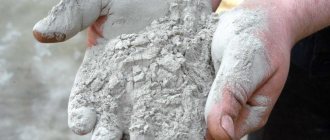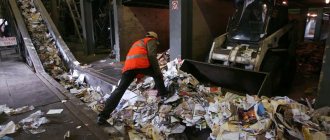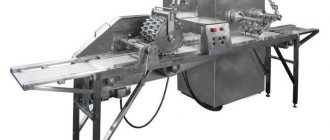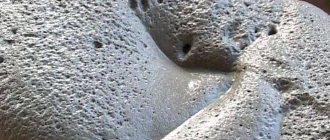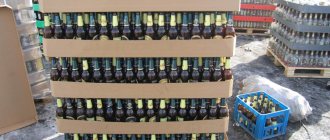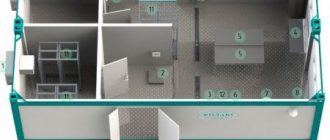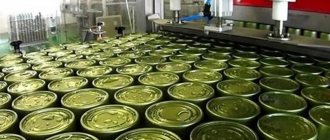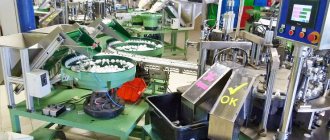In Russia they are just beginning to seriously think about the total recycling of plastic bottles. Due to the presence of huge areas that can be used to organize giant landfills, the Russians did not particularly care about the proper disposal of PET containers.
Hazardous waste dumps are growing, and with them the problem of environmental pollution is growing. If you don't give it proper attention, it can become irreversible.
Hazard class of PET waste
Plastic containers that are actively used by the population and enterprises are marked with markings that can be used to determine what raw materials were used in the manufacture of the bottle:
- PVC – polyvinyl chloride;
- PS – polystyrene;
- PET – polyethylene terephthalate;
- LDPE, HDPE – low and high density polyethylene, respectively;
- PP – polypropylene, etc.
Most often we see the PET symbol on a bottle, since polyethylene terephthalate is the material from which most bottles are made. Therefore, we will consider the problem of recycling plastic bottles using his example.
PET waste is recognized as non-hazardous and classified as hazard class 5. This does not mean that waste from the type of plastic described cannot harm the environment.
According to Russian technical specifications, bottles with the PET mark must be sorted by color:
- transparent;
- unpainted;
- dark;
- blue;
- green, etc.
Important: Most of the waste generated by Russians every year is plastic bottles. Every year, the country's landfills are replenished with hundreds of thousands of tons of PET waste.
Recycling process
So, the processing process includes five stages:
- To begin with, the bottles are sorted by color because they are processed separately.
- After this, the vessels are cleaned of dirt - this operation is carried out only manually.
- The bottles are sent to a recycling line where the caps and labels are removed .
- After the bottles are crushed any remaining debris and contaminants are removed from them .
- Next comes washing, thoroughly rinsing and drying . Only after these operations is the plastic considered recycled.
The result is a raw material similar to multi-colored or white flakes. This raw material is called flex.
How harmful are PET bottles to the environment?
Plastic has many benefits, but biodegradability is not one of them. The products do not rot and can take up space in landfills for hundreds of years.
You might think that the time will come when we will all begin to resolve the issue together, empty the landfills and recycle everything that is lying around. The time has come. Along with the welfare of Russians, domestic landfills are growing and multiplying. The stench from their contents has already reached the borders of many cities. And this is just the beginning.
The outlines of Russian landfills can be seen in photographs taken from space.
PET waste recycling technology
To melt the described material, you need to heat it to 250°C. The molten substance is endowed with a number of properties that are taken into account during processing:
- is resistant to alkalis and weak acids;
- does not dissolve in gasoline;
- does not dissolve in water.
The entire process of material processing consists of the following stages:
- Collection of plastic dishes.
- Sorting of containers.
- Grinding of material.
- Washing.
- Removing foreign fractions – stickers, caps;
- Secondary washing.
- Drying.
- Granulation.
Let us highlight the main stages from the above.
Sorting of raw materials
Even before washing and processing, raw materials are carefully sorted. The need for sorting is due to the fact that dishes can be made from various materials. The cost of the final product is also affected by the color of the products:
- Colorless - more expensive than other types, as they are universal and suitable for use in most areas.
- Brown ones are the cheapest and highest quality. The material is poorly rated because there is no technology to change its color.
- Blue and green are the second cheapest after brown flex.
Important: Red containers, as well as containers with residual detergents, milk and butter, are set aside separately. The process of their processing is more complex. They also separate out everything that is not PET.
The industry produces special equipment that performs automated sorting of plastic material. At Russian plastic processing plants, manual labor is most often used for sorting.
Cleaning and crushing process
The next important stage of processing is the purification of raw materials. It comes into production with extraneous non-plastic elements. Plastic containers are cleared of contents. Dust, dirt, labels, covers and other extraneous items are removed.
The dishes are washed with a hot aqueous solution with the addition of caustic soda. After the initial washing, drying follows in a special device that speeds up the process.
Washed and cleaned PET is crushed in a crushing device to a size of 1-2 cm. There is equipment that allows simultaneous crushing and additional washing at this stage, which ensures a higher quality raw material at the output.
Clean dried flakes are packaged in 30 kilogram bags. The entrepreneur can sell the intermediate product or further process it. The decision depends on what equipment the production is equipped with.
Agglomeration and granulation processes
Flex can be processed into granules. According to the technology used in factories, raw materials are first subjected to agglomeration - sintering of plastic flakes using special knives heated to temperatures above 100°C.
Necessary equipment for recycling plastic bottles
Recycling plastic bottles is an expensive business. According to the most “modest” estimates, you will have to invest from 5.5 to 7 million rubles in organizing a business. A ready-made imported mobile plant for processing plastic bottles will cost 180-190 thousand dollars. Perhaps the only drawback of such a plant is its price. Everything else meets all the conditions for creating a truly successful profitable business. Such a mini-plant does not require premises - it is assembled in a container, the processing line is 6 meters long, which allows it to be easily transported by a heavy-duty vehicle throughout the region.
Stationary processing will cost much less. However, there will be much more hassle with organizing a business. You will need to search for suitable premises to rent, equip it for production needs, and have a larger number of personnel. But the equipment itself, especially if purchased separately, will be cheaper than a ready-made line.
A standard PET bottle recycling line consists of:
- Belt Conveyor
- Rotary grinding apparatus
- Apparatus for washing, squeezing, and drying raw materials
- Centrifuge for separating dust generated during plastic shredding
- Furnace for agglomeration (sintering)
- Granulation machine
- Receiving hopper
The buildings of old abandoned factories are suitable for a processing workshop, but these are now difficult to find - almost everything is already occupied by your fellow businessmen. As an option, you can build a prefabricated hangar yourself. Its cost is relatively low, and the time for completing the work is from 1 to 3 weeks, depending on the area and height of the building.
Recycling PET bottles as a business idea
Recycling polyethylene terephthalate can be a promising business idea. A properly developed business plan, based on careful market research, will become a guide to prosperity. You can organize a factory or a mini-factory. It is important to consider a number of points:
- business registration is required;
- a license is required to carry out activities;
- it is necessary to coordinate the opening of the enterprise with the SES and fire service;
- You should rent space for warehouses and a production workshop.
It is advisable that the processing plant be located away from residential areas.
Equipment needed for recycling PET bottles
The decision on what equipment you will use to recycle plastic bottles should be made in advance. Knowing which units will be used, it is easier to find a suitable area for their placement.
Suitable equipment can be found both in the lines of imported companies and domestic brands. The latter are more affordable, but they are inferior in quality to their foreign counterparts.
The line should include:
- crusher;
- agglomerator;
- granulator.
The modules will be connected to each other by a transporter, which should also be included in the acquisition plan.
The final cost of the set depends on a number of factors:
- whether you assemble the line yourself or purchase a ready-made complex;
- line equipment;
- power of units;
- degree of automation, etc.
The average cost of a finished line is 3,000,000.00 rubles. It will be cheaper to assemble the line yourself. If you are short on funds, you can find high-quality used devices.
At the first stage of business formation, you can limit yourself to equipment for producing flex, and when things get going, purchase a granulator and an agglomerator.
To produce flex, it will be enough to buy:
- crusher;
- bath for washing raw materials;
- centrifuge.
All this will cost an average of 500,000.00 rubles.
Even before starting a business, you also need to worry about hiring staff, paperwork, the sales market and the places from which raw materials will be delivered.
A properly set up business pays off within 2-3 years.
Flex production technology
Once the bottles are collected, they need to be prepared for recycling. Products are sorted by color: painted and transparent. PVC containers are also selected separately. Bottles are cleaned of paper, stickers, and other materials other than plastic.
In the second stage, the material is pressed. In this form, it is supplied for further processing to an automated line. Mini presses are often installed at container collection points. After such processing, the products become more compact and are easier to transport to the processing site. The stages of technology performed on it can be represented in the following sequence:
| 1 | Cleaning of foreign materials in a rotary machine. |
| 2 | Grinding in a crusher. It works on the same principle as a blender, but is larger in size. |
| 3 | Removing residual contaminants, metal or paper impurities in a steam boiler. |
| 4 | Cleaning in a rinsing machine. |
| 5 | Drying crushed plastic. |
| 6 | Flex storage in a bunker. |
How to recycle plastic bottles at home?
It is possible to recycle plastic bottles into raw materials for home production.
Important: If you intend to start recycling at home, remember safety precautions. An improperly organized process can cause harm to health.
Old bottles can be used to plant seedlings or indoor plants. You can use them to make bird feeders and many other useful things.
Where can I take waste PET bottles?
If you don't think about making anything at home, you should take care of where to take PET bottles for recycling.
Companies that recycle bottles are interested in collecting containers. To bring production closer to the population, they organize collection points for plastic utensils. You can find them via the Internet.
Also, used PET containers can be placed in special waste collection containers. This collection method is already being implemented in many Russian cities.
